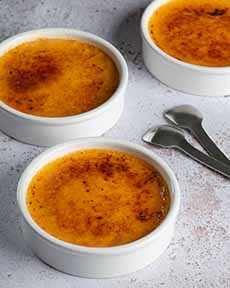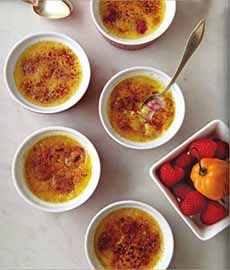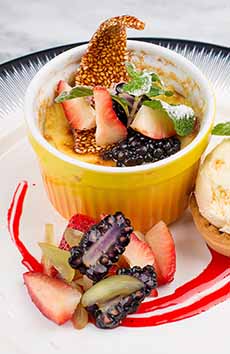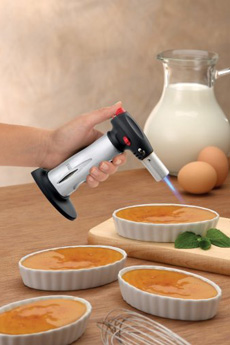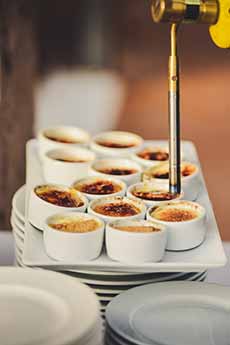Creme Brulee Recipes & History For National Creme Brulee Day
|
July 27th is National Crème Brûlée Day, celebrating a French dessert that has remained on menus across the U.S. long after Coupe aux Marrons, Île Flottante, Mont Blanc, and other classic French desserts have disappeared from menus in the U.S. Crème brûlée first came to America with Thomas Jefferson’s return from France in 1789 [source]. But it didn’t take hold (more about that below). Crème brûlée is a type of custard made of all heavy cream (no milk), egg yolks, sugar, and vanilla. It’s topped with a brittle layer of caramelized sugar (brûlée is French for burnt, crème brûlée means “burnt custard”). In addition to the delicious flavor, some fun is to be had by cracking the hard sugar with one’s fork. Who created such a delectable dessert? Crème brûlée recipes seem to have emerged in the 16th century, in the English countryside (some sources say the 15th century). During the spring calving season, the milk was especially rich, and farm women would prepare a very thick custard to use up the milk and take advantage of its richness. Some say the burnt sugar was added later, at Trinity College, Cambridge University, in 1879. A student is credited with the idea of branding the school crest into a topping of sugar, burnt with a hot iron rod fashioned with the crest. The recipe was called Cambridge Cream or Trinity Cream and has been a popular item on the school’s menu ever since [ibid]. But let’s step across the Channel to France, 200 years earlier. The earliest known printed recipe anywhere for crème brûlée appeared in the 1691 French cookbook, Le cuisinier royal et bourgeois by Chef François Massialot (1660-1733—click on the first link to read the book for free). In Massialot’s recipe, the sugar topping was melted and burnt with a red-hot fire shovel*, then placed on top of the custard [source]. By the 18th century, kitchen tools included a salamander. A round, flat, thick plate attached to a long handle, it was heated over the fire and then used to brown foods (photo #7). (The first blowtorch, from which the kitchen torch is adapted, wasn’t invented until 1882. Here’s an early adapted version used by Julia Child around 1963.) Massialot’s crème brûlée recipe added a disc of caramelized sugar onto the custard, instead of burning the sugar directly on the dessert as was done later. A bit more about this great chef: An innovation in Massialot’s cookbook was the alphabetization of recipes, a step toward the first culinary dictionary. The recipe for meringues also made its first appearance published by Massialot [source]. As mentioned earlier, Thomas Jefferson brought the recipe back from France in 1789, and had his cook make it. But it didn’t become part of the American dessert repertoire. Over the centuries, as crème brûlée became better known internationally, recipes began to appear in American magazines and cookbooks in the 1950s and 1960s. But its breakout came in the 1980s, thanks to Le Cirque restaurant, one of the top French restaurants in New York City. It got lots of press and became one of the “it” desserts [source]. Home cooks as well as restaurants could burn the sugar under the broiler. There was also the salamander, although few home cooks would want to use one (a very hot metal rod!). Then came the butane torch, or kitchen torch (photo #5). Suddenly, crème brûlée was relatively easy. Today, you can find one for less than $20 (although we’d go for a brand name, at possibly twice that). And they’re not just for crème brûlée. Here are 15 more uses for a kitchen torch. As crème brûlée evolved, it became flavored: butterscotch, chocolate, cocktail-flavored (Irish Coffee, Margarita, Piña Colada, White Russian, etc.), coffee, Earl Grey, eggnog, fresh and dried fruit of every description, green tea/matcha, lavender, mocha, Nutella, pie-flavored (Key lime, pumpkin), salted caramel, s’mores, snickderdoodle…need we go on? And then, of course, the crème brûlée flavor was ported to everything else: brownies, cakes/cheesecakes, chocolates, coffee, coffee creamer, cookies and cupcakes, doughnuts, French toast, fudge, ice cream, even McCormick Flavor Inspirations Crème Brûlée Seasoning to sprinkle on coffee drinks and “your favorite breakfasts, desserts, and dips.” It’s a limited edition: Get it while you can. Crema catalana (“Catalan cream”) is the name used for the dish in most of Spain (photo #7), but strangely, it is called crema cremada (“burnt cream”) in its home province of Catalonia. The dish is similar to crème brûlée. Similar, but not identical. While both are custards made from egg yolks and sugar, crème brûlée is made with cream, while crema catalana is made with milk. The basic crème brûlée recipe is flavored with vanilla, while crema catalana is often flavored with lemon zest or cinnamon, as well as vanilla. Both have a burnt sugar topping. In the annals of time, crema catalana is older. The first known recipe appears in the medieval Catalan cookbook Llibre de Sent Soví, in the mid-14th century. That’s three centuries before Massialot’s crème brûlée recipe. As with crème brûlée, the sugar was sprinkled over the cooked custard and subsequently burnt with a hot iron rod. > The different types of French crèmes. > The different types of custard. > Types of custard: creme brûlée, creme caramel, pot de crème. > The difference between custard and pudding. ________________ *The definition of a fire shovel from the 1770’s is, “an instrument to throw coals on a fire with.” They were initially made of iron [source]. |
|
|
|
CHECK OUT WHAT’S HAPPENING ON OUR HOME PAGE, THENIBBLE.COM.
|
||
